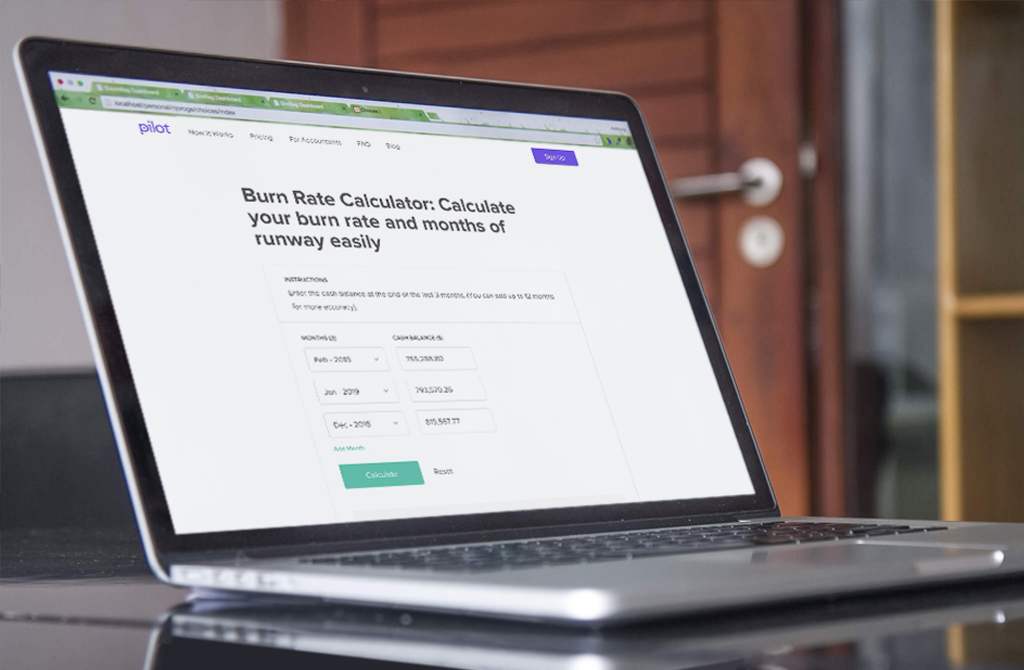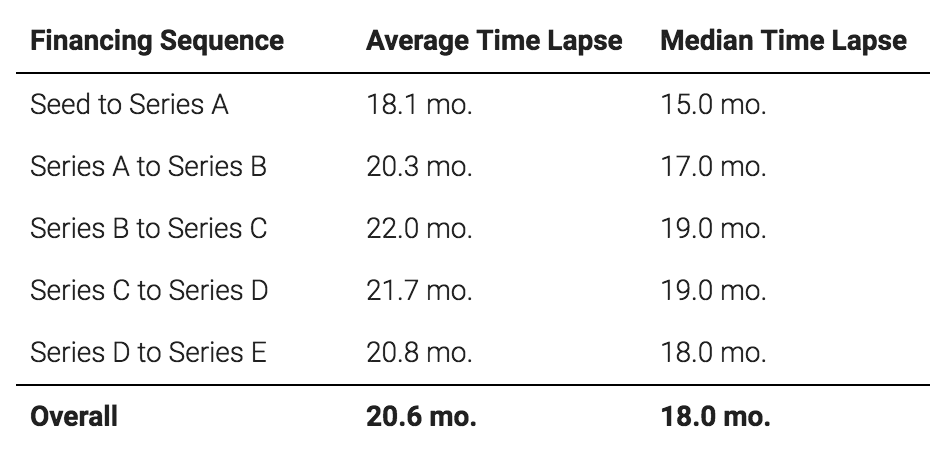Burn Rate Calculator: Calculate Your Burn Rate and Startup Runway
A confirmation email has been sent to your email.

Use the calculator below to figure out your burn rate and months of runway based on the cash balance in your bank account for the last few months. Enter at least 3 months, but you can get a more accurate answer if you enter more (you can enter up to 12).
Below the calculator, you can learn more about how to calculate the burn rate yourself, how runway and burn rate are related, typical burn rate and runway for startups at different stages, and more.
Want someone to hand you this information every month, rather than doing it yourself? At Pilot, we offer one of the best bookkeeping services around. Try Pilot Now.
How to Calculate Burn Rate
Calculating startup burn rate is actually pretty simple. Burn rate is the actual amount of cash your account has decreased by in one month. Most of the time, it describes a company’s negative cash flow. It doesn’t include outstanding obligations, money that was transferred into another account, or money that’s on its way.
Some people make a distinction between two types of burn rate: gross burn rate and net burn rate. We think this complicates things unnecessarily. Here’s why:
Gross burn rate is the amount of cash that you spent in a single month. It does not take total revenue (incoming cash) into account.
Net burn rate takes the incoming revenue from cash into account. So net burn rate is your cash lost in a single month. In other words, you subtract revenue from spending and use that number to calculate your net burn rate. Net burn rate helps you understand how much more revenue you’d need to break even and how much longer you have until you run out of money if nothing changes.
To simplify things, we just refer to net burn rate as burn rate. There are two ways to calculate your burn rate: with and without venture capital (VC) or other investor funding.
Including Investor Funding
The easiest place to find the information you need is in a cash flow statement (also called a statement of cash flows). If you want to know your burn rate while including VC funding, then you don’t need to make any adjustments to the numbers you see.
To find burn rate for a given month, subtract the cash balance for the month from the cash balance in the previous month.
Burn Rate = Cash balance in prior month – Cash balance in current month
Simply put, burn rate is the net cash you are spending every month.
What Does It Mean if Your Burn Rate Is Negative or Zero?
Normally, the calculation above results in a number equal to or above zero. But there are a few situations in which your burn rate may come back as negative. That means that you’re earning more money than you’re spending. Say you just scored a round of funding — your burn rate might show as negative for that month because you appear to be gaining money overall.
If you haven’t added any investor funding, it could indicate that your revenues are finally greater than your expenses. If your burn rate is zero, it indicates that you’re earning and spending an equal amount of money. But once your startup is earning more than its spending, burn rate is meaningless. As a metric, it’s only helpful for startups that still have higher expenses than revenue.
Excluding Investor Funding
Many startup founders want to know their burn rate regardless of ongoing funding. It’s the same calculation, but you should first subtract any recent funding from your total cash, when relevant.
Burn Rate = (Cash balance in prior month – VC funding) – (Cash balance in current month – VC funding)
This is helpful if you want to know how close you are to recouping expenses just from revenue-generating activities. It’s also the first step in knowing how long your business would last if you stopped fundraising.
Calculating Average Burn Rate
If you’d like your average burn rate, repeat the process above for as many months as desired. Add the monthly burn rates together and divide by the number of months included. For example, to get your three-month average burn rate, you would add the burn rates together and divide by three. The calculator above will give you your average burn rate in addition to your company’s burn rate for each month included.
How Burn Rate and Startup Runway Are Related
Your burn rate calculation can be used to calculate runway (i.e., the number of months you have left before your business runs out of cash). Since burn rate reflects the net cash that left your account in a month, you can use that trend to extrapolate and see how many months it would take before you “burn” through your cash balance. Here’s how to calculate startup runway.
How to Calculate Runway
For this calculation, it’s more accurate to use your average burn rate (which you can obtain from the calculator above or by hand). Taking that average burn rate, divide the amount of money you have now by your burn rate.
Runway = Total cash held ⁄ Average burn rate = # months before you run out of money
The resulting number is how many months you have left before you run out of money (assuming expenses and revenue are constant and that you don’t add additional VC funding).
If you’d like to see a graph of your runway, the calculator above will generate that for you.
An Example Startup Runway Calculation
Let’s say your current cash holdings are $150,000 and last month’s cash holdings were $200,000.
Burn Rate = $200,000 – $150,000 = $50,000
Since you currently have $150,000, we can use that information to calculate your runway:
Burn Rate = $150,000 / $50,000 = 3 months
In this example, your startup has only 3 months of cash before running out of money.
Does Your Startup Have Enough Runway?
Interpreting burn rate and runway is your job (or that of your CFO, Director of Finance, or accountant, depending on who you have helping you). Knowing how much cash you’ll need will be an ongoing evaluation as you build the business.
Do you have enough runway? That depends on how long you think it will take before you secure more funding or start earning sufficient revenue to offset expenses.
If you only have three months of runway but your product won’t launch for another six months, then clearly, you don’t have enough runway. But if you have rising revenues and a product that’s recently launched, three months of runway is less worrisome (though it is still worrisome). You’d also be in good shape if you’re expecting to score funding in a month or two.
As you can see, the interpretation of runway and burn rate is specific to the details of a given business. Nonetheless, it can be helpful to see typical runway numbers for startups at different stages so you can gauge things such as how much financing you may need and how quickly you should spend investor money, using average numbers as a general ballpark.
Sebastian Quintero, Head of Data Science at Radicle Labs, crunched through a large number of financing statistics from Crunchbase and posted this chart in his Medium post on how much runway you need:

By using that chart and your runway numbers, you can determine how far off you are from the average. By extension, if you only have ten months of runway when most people need 20 months to get from Series A to Series B, you might want to examine ways to increase your runway or lower your burn. Or you may simply be aware that you are different from average but know the details of your business make that okay (for example, if you are expecting revenue earlier than typical startups at your stage).
Should You Reduce Your Burn Rate?
If your burn rate seems high compared to your peers, or if the amount of runway left makes you nervous, it’s worth looking at what’s causing your burn rate.
Many founders are quick to assume they should reduce their burn rate, but that’s not always the case. It depends on how you’re spending your money and what that does for your company. If you have a high burn rate but the money is allocated to paying top-notch engineers, salespeople, and marketers, for example, then it’s probably money well spent.
But if you find that you’ve purchased subscriptions to tools your team isn’t using or that don’t move the needle enough, that could be a place to cut costs.
Ultimately, you’re the one who must decide if your burn rate is reasonable for how you’re investing in your company’s future.
Conclusion
Besides getting an accurate picture of your company’s financial health, knowing your burn rate and runway is an important step in securing funding. Some venture capitalists believe your company’s burn rate is a key metric for decision-making, especially if you haven’t launched a product yet.
These are numbers you’ll want to have ready if investors inquire (and they will). If you’re not planning to pursue funding again, then it’s part of a larger analysis demonstrating how much revenue you need — and when you need it by.
Want someone to hand you a burn rate report, rather than doing it yourself? At Pilot, we offer one of the best bookkeeping services around. Try Pilot Now.


